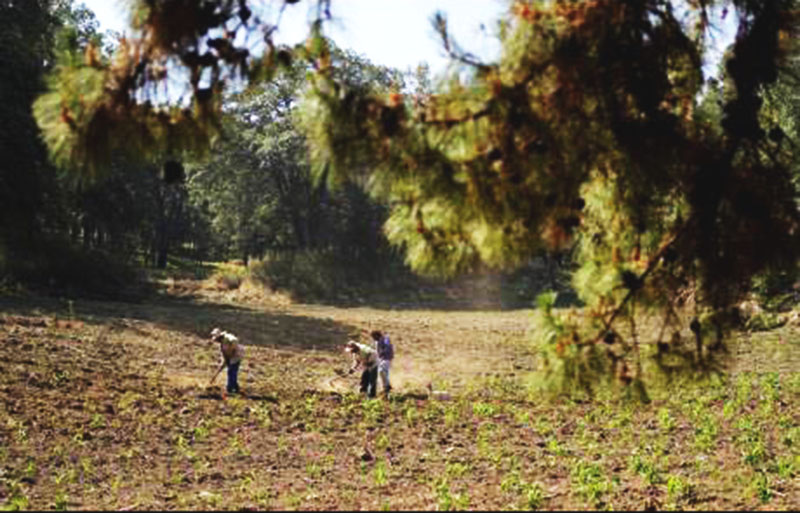The corn has begun to sprout on the hillsides south of Mexico’s capital, though it’s unclear whether these shoots will have enough water to grow or whether the farmer will be able to afford the increasingly expensive fertiliser.
What is known is that the government of President Andrés Manuel López Obrador wants Mexicans to produce more of their own food in order to move toward self-sufficiency in key products and to control prices for basic foodstuffs. The president’s idea, which involves giving rural families cash payments to grow crops and technical advice, isn’t new, but the ravages of the pandemic, climate change and market turmoil created by the war in Ukraine have given it new urgency. The government wants to head off food insecurity in a country where 44 per cent of the population lives in poverty and where 27.5 million tons of corn are produced, but more than 40 million tons are consumed, according to government data.
Some farmers hope for additional state financial help and subsidised fertiliser. Others are suspicious of government plans. But all hope that this year’s harvest produces enough to feed their families and with luck a bit more to sell in their communities.
While G-7 countries look for global solutions and the United States and development banks prepare a multibillion-dollar plan to ease food insecurity, the United Nations Food and Agriculture Organization, FAO, has welcomed Mexico’s efforts toward self-sufficiency in basic foods, but does not expect quick results.
“We do not see food prices going down, at least this year,” said Lina Pohl, the organisation’s representative in Mexico.
The government said it hopes that those participating in the programme will increase their production of corn and beans by about two thirds. Brothers Arturo, Benjamín and Víctor Corella, three teachers who in their retirement are farming family plots in Milpa Alta in southernmost Mexico City, know everyone is having a rough time, but they are optimistic because after only one year in “Sowing Life,” or “Sembrando Vida” – one of López Obrador’s signature programmes – they harvested 1.5 tons of corn where they had previously only gotten one.
“The most important reason for planting is that (the whole family) has self-sufficiency in corn, not having to go buy tortillas, but rather try to do it ourselves,” said Benjamín. Now, he said, a government technician coaches them through their planting strategies, improving their yield.
AMBITIOUS REFORESTATION
“Sowing Life” was publicised as an ambitious reforestation programme that aimed to plant a million hectares of trees producing fruit and lumber. It was also hoped that giving rural families a sustainable source of revenue and a monthly cash payment would keep more of them on their land rather than migrating north.
But the programme also included a lesser-known option that López Obrador now hopes to amplify. Some enrollees could choose to receive monthly payments to grow what in Mexico is known as the ‘milpa’, corn, beans and squash grown together as has been done for centuries.
The “Sowing Life” programme counts with an investment of nearly US$4 billion and some 450,000 participating growers, each of whom receives a monthly US$225 payment from the government. The real number of people involved is far larger though, because to qualify each grower needs to farm 2.5 hectares – more land than many farmers have – and often entire families or even communities pool their land like the Corellas.
Despite the government’s use of the programme to counter its less-than-stellar environmental record and doubts about its scientific underpinnings, few have questioned its social impact.
Housed in Mexico’s social welfare – not agriculture – ministry it generates work and food by supporting farmers with technical advice and monitoring.
The FAO sees it as a “fundamental programme” helping small farmers to improve their quality of life and produce in healthier ways. Ariadna Montiel, secretary of the welfare ministry, said the goal is to expand the programme and offer new support to those already enrolled so they can farm more land, add new crops or start to produce and use organic fertilisers.
That’s precisely what the Corella brothers have in mind.
Montiel said the effort’s results will be seen in four or five months when corn is harvested, but only the growers’ communities are likely to see the prices of those basic foods drop. “If we think about these families, which are the poorest, having this (food self-sufficiency) guaranteed, we remove a concern,” she said.
If they have more than they can eat themselves, they can sell it locally or to the government for a fair price to supply its food programmes for the most marginalised.
STRONG ECONOMIES
Strong economies including the United States, Japan and European nations have opted for self-sufficiency as well subsidising certain products, even though buying from its producers is more expensive than importing.
In the late 1990s, with the North American Free Trade Agreement, many Mexicans began buying cheaper US corn and stopped farming their land.
While the FAO defends self-sufficiency efforts in food production, it emphasises that international trade is crucial for all economies.
Some Mexicans have returned to the land without the government’s assistance for reasons either personal or ideological.
“Planting is an act of resistance,” in the face of Mexico City’s growing urban sprawl, said Ana Martínez, an accounting assistant and single mother, who during the pandemic decided to begin farming her grandfather’s land in Milpa Alta.
“It’s about generating consciousness in the community and not abandoning” the land, she said. Martínez belongs to a land defence collective and spends part of her weekends weeding in preparation for her first harvest. She said the government’s programme might help some people, but she viewed it as charity. “With land we can survive.”






